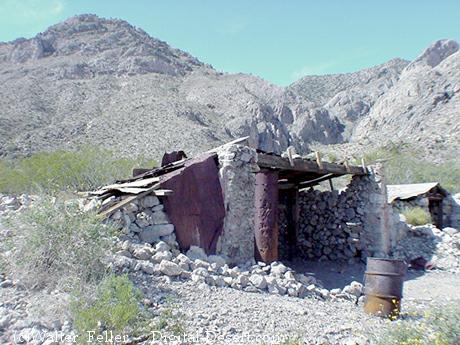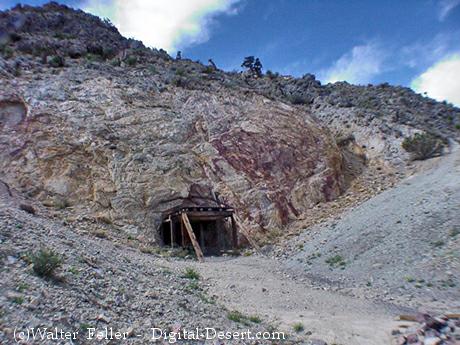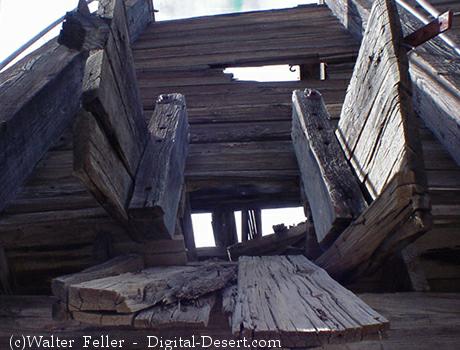San Bernardino County:
Providence
In the spring of 1880, George Goreman and P. Dwyer, prospectors from Ivanpah, discovered rock that assayed from $640 to $5,000 a ton in silver. Their discovery, about 15 miles south of the old Macedonia District, was the birth of the Bonanza King Mine. By April the Trojan District had been organized, and a rush to locate claims had resulted. Andy McFarlane and Charley Hassen “concluded to try their luck, and were rewarded by the discovery of a wonderful bonanza.” Some of the other nearby mines included the Rattler, the Treasury, the Lucknow, the Mozart, and the Cashier. 92
On July 3, 1880, it was reported that ore was being prepared to ship to the Ivanpah Consolidated Mining and Milling Company at Ivanpah from the Bonanza King. However, further development was hampered by a lack of capital. Sometime around the spring of 1881, J. D. Boyer and H. L. Drew, San Bernardino businessmen, purchased the mine. In June, 1881, they also paid $20,000 for the Pierce Mine. This was probably a good investment, seeing that $28,000 in ore had already come out of it, yet the remainder of 1881 is notably lacking in information from the mines. In December, 1881, J. B. Osborne, H. L. Drew, J. D. Boyer, and N. Hasson sold all their interest in the old Amargosa Mining District for $22,500. This sale gave H. L. Drew and Mr. Hasson, now in partnership with Mr. Osborne (of
Calico fame), some extra money. Work was to begin at once on the Bonanza King, and negotiations for sale of their mines in the Providence Mountains were stopped. 93
On the Bonanza King, in January, 1882, a rich vein assaying $100 to $1,200 per ton was discovered and a plan was “on foot to erect a large mill there in a short time.” Instead of going through with these plans themselves, they sold the mine to the Bonanza King Consolidated Mining Company, reportedly for $200,000. 94
In July, 1882, a new hoisting works arrived for the Bonanza King Mine via Colton, and a ten-stamp mill built by Prescott, Scott and Company of San Francisco was freighted from Mojave by Remi Nadeau. All was in preparation for the mill. Between 100 and 150 men had actively been employed since May or June. The main shaft was being sunk by 3 shifts of men, and some 2,000 tons of ore worth $230 a ton sat waiting on the dump. A post office had opened in June, and the town of Providence was born. 95
In the meantime, the
Southern Pacific was rushing its way east from
Mojave to stop the A and P before it reached California. The S. P. Railroad was open to
Waterman (Barstow) on October 23, 1882, and to Goffs on March 19, 1883. This no doubt was pleasant news to the owners of the Bonanza King who, in January, 1883, shipped their first 11 bars of bullion worth $19,000. During the first 12 days of February, they shipped an additional $28,300 in bullion. The mill was turning out 2,000 ounces of 930-fine silver a day! 96
In July, 1884, Thomas Ewing, the superintendent, reported ‘the Bonanza King is better opened up, better worked, and we have obtained better results from the ore than any other mine in this great mineral desert. Nearly one million dollars has been taken out from the mine in 18 months and ten days.' 97
The mine continued to make good profits, but at a high cost. A February 3, 1885 letter to the Calico Print blasted foreman H. C. Callahan and shift boss John O'Donnell for being “heartless task masters.... forcing men to work more than their health and strength will permit.”
On March 11, 1885, the mines and mill were shut down, and virtually all the miners left. About a week later, the mines reopened with only 15 miners who earned $3 instead of the previous $4. The owners claimed the low price of silver forced the action. By the end of March, 35 to 40 men were back at the mine, which previously employed from 150 to 200. In order to attract additional workers, the company purchased advertising space in the Calico Print. 98
It was not until about June 20 that the mill started up again. The company was milling 24 tons of ore a day, and in one month, 24 bars of bullion had been produced. However, just two weeks later, on July 31, 1885, the mill burned to the ground, “the mines closed down and the owners, after collecting the insurance, went east, probably with a sign of relief.” 99
In 1890 Dr. Henry De Groot reported that the mine had produced $60,000 a month, “the ore averaging one hundred dollars per ton.” The mill operated more or less continuously from January, 1883, to March, 1885, and during June, 1885. This is a total of 28 months which would equal about $1,700,000. 100
The spring after the mill burned, the Wallapai Tribune reported that a railroad was being surveyed to Providence and that a smelter would be erected at Needles as soon as the railroad was completed. In 1890 it was rumored the company intended to erect a twenty-stamp mill to replace the old mill, but this was not done.
Little took place on the Bonanza King property in the 1880s after the mill burned, but at the nearby Kerr Mine, a five-stamp mill was erected late in 1885. This mill ran continuously at least until 1890 and paid good dividends. 101
In 1906 the Bonanza King Mine was reactivated by the Trojan Mining Company. They installed a ten-stamp mill powered by three gasoline engines. The mine was active only until September, 1907, but the property was examined and a thorough report was written. This aroused a great deal of interest, and in 1914 Hall Rawitser and Company of Massachusetts purchased the mine, beginning development work. With Mr. J. C. Gerney as superintendent, the mine was again a producer by 1915. 102
The company totally revamped the mill, and during 1919 was treating 40 tons of the old dumps a day. Some rich ore at this time was shipped and reportedly carried 100 to 500 ounces of silver a ton. Operations were suspended in 1920. During 1923 the property was leased to the Bonanza King Consolidated Mines Company, and 6 men were employed, working on the third, fourth, fifth, and sixth levels. One carload of ore was shipped in May, 1924. 103
p. 92, paragraph 5
During revivals of mining activity at the Bonanza King mine during this century, two articles were published which give insight into the early history of this mine. On February 10, 1906 The Mining World gave this account:
In the Trojan mining district of the Providence Mountains are located the properties of the Bonanza King Development Company of Los Angeles. This property carries with it a history of the mining upon the desert years ago, for about 1990 a 10 stamp mill and amalgamation plant were shipped by rail from San Francisco to Mojave and form there to the mountains, costing in the aggregate over $50,000. After its completion and before its destruction by fire in 1885 it produced, according to shipments by Wells-Fargo Company, over 1,800,000 silver bullion. At that time the property was owned by Wilson Waddingham and Colonel Tom. Ewing. Afterward it was bought in at sheriff's sale by J.H. West of Needles, Cal., and by him sold to Philadelphia parties. In April, 1905, the Bonanza King Development Company was organized.
The article below, found in The Salt Lake Mining Review of November 30,1925, is most likely inaccurate. The four prospectors mentioned are probably none other than Osborne, Drew, Boyer and Hasson.
It is somewhat ancient history, but it is chronicled that the Bonanza King was discovered by four prospectors. Before much work had been performed in the development of this rich prospect Thomas Edwin (sic), mining scout for George Hearst of San Francisco, father of W.R. Hearst, owner of Hearst publications, attracted by the rich promise of the new discovery, asked if it was for sale, and at what price.
‘There are four of us,' was the reply, ‘and we want $50,000 each.' ‘It's a sale,' said Ewing, as quick as a flash and securing a piece of rough wrapping paper, he immediately drew a draft for the amount. It read: ‘George Hearst, San Francisco; pay to bearer $200,000. Within forty-eight hours the draft was paid though Wells Fargo.
The mine, according to the story, later produced millions in gold for Hearst, who finally sold it to an English syndicate for several millions more.
Bonanza King Mine
Bonanza King Mill
Providence Ghost Town



